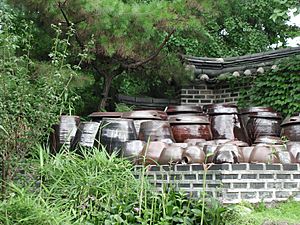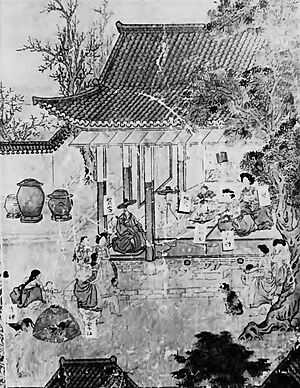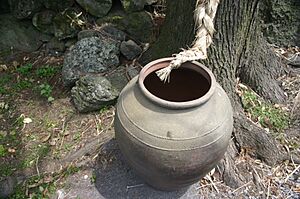Onggi facts for kids
| Onggi | |
 |
|
Quick facts for kids Korean name |
|
|---|---|
| Hangul | |
| Hanja | |
| Revised Romanization | onggi |
| McCune–Reischauer | onggi |
Onggi (Korean: 옹기, 甕器) is a special type of Korean earthenware. People in Korea use it a lot for serving food and storing things. Onggi can be either unglazed (without a shiny coating) or glazed (with a dark brown, shiny coating).
The unglazed type is baked at lower temperatures, around 600 to 700 °C. The glazed type is fired at much higher temperatures, over 1100 °C. Onggi has been around for a very long time, possibly since 4000 to 5000 BC!

Early types of onggi included simple, patternless pottery. There were also red and black kinds. The color of the pottery depends on the iron in the clay and how it was heated. The onggi shapes we see today mostly come from the Joseon era in Korea. Old books like Sejong Sillok Jiriji even mention where onggi was made.
Contents
Discovering the History of Onggi Pottery
Onggi pots have a long and interesting history in Korea. The word "Ong" (옹) means "pottery" or "pot" in Korean. People on the Korean peninsula have used pottery for storing food since ancient times.
Onggi Through the Ages
During the Three Kingdoms period, you can see pictures of onggi pots in old murals. These murals are found in places like Goguryeo, Baekje, and Silla. Records show that people used onggi to store important things. This included rice, drinks, oil, soy sauce, and even salted fish. Onggi was also commonly used to keep drinking water fresh.
In the early Joseon dynasty, there were many "Ongjang" (옹장). These were special workshops that made onggi. An old book called ≪Ggyeong-guk Dae-jeon≫ mentions these workshops. It shows how important onggi was in daily life.
How Onggi Helps Fermented Foods
Onggi pots are very special because they have tiny holes. These holes make the pottery "breathe." This feature is super helpful for making fermented foods.
The Magic of Fermentation
Many famous Korean foods are fermented. These include gochujang (a spicy chili paste), doenjang (fermented bean paste), kimchi (spicy fermented vegetables), and soy sauce. Onggi pots help these foods ferment perfectly. The tiny holes allow air to flow in and out. This helps the good microbes grow and makes the food taste great.
Korea is well-known for its fermented foods. Ancient Chinese writings even mention that Goguryeo people had a custom of making them. Korea has lots of soybeans and fresh seafood. The climate is also good for microbial growth. All these things helped fermented foods become a big part of Korean cuisine.
Where Onggi Pots Are Stored
Large onggi pots were usually kept on a jangdokdae. This is a special raised area near a Korean house. It helped keep the pots safe and at the right temperature.
Unique Features of Onggi Pots
Onggi pots are made by skilled workers called onggijang (Korean: 옹기장). The way they are made can change depending on the region. But all onggi pots share some cool features.
Breathable and Strong
Onggi pots are known for being able to "breathe." When the clay is heated, tiny pores form in the pottery walls. These pores let air pass through. This is why onggi has been known as a breathable pot for a very long time.
They are also strong and resistant to rot. This makes them perfect for storing food for a long time.
Perfect for Fermentation
The most important thing about Korean food is its use of fermented dishes. Onggi pots are essential for this process. They create the perfect environment for fermentation. Besides food, onggi can also store other things. People have used them for tobacco, candles, and even cooked rice.
Affordable and Versatile
The materials to make onggi are easy to find and cheap. This means onggi pots have always been affordable for everyone. They are not just for food. Onggi can also be used for household items like lamps, ashtrays, and even musical instruments.
How Onggi Pots Are Made
Onggi pots are made from a special type of clay that has a lot of iron. The process involves several steps.
First, the clay is put into water and mixed. This helps remove sand and other impurities. Then, the fine clay sediment is shaped into a pot. This pot is then dried in the sun.
Next, the potter dries the pot again and washes it with a special solution. After that, a glaze is applied to the pot. This glaze is a mixture of different substances. It helps make the pot waterproof and prevents leaks.
Sometimes, patterns of orchids or grass are drawn on the pot. The pot is then air-dried completely. Finally, it is baked in a hot kiln to finish the process.
Another way to make onggi is called Panzhangjil (판장질). The clay is kneaded and dried in the shade. Then, it's cut into a brick shape and flattened into a plank. This plank is placed on a potter's wheel. The potter uses a tool called a Ddukmae (떡매) to shape the onggi. The final shape depends on how fast the wheel spins and the potter's hand movements.
After the 1960s, plastic and stainless steel containers became popular. It seemed like onggi pottery might disappear. But in 1989, the Korean government recognized its importance. They designated the Onggijang (Onggi technician) as an Important Intangible Cultural Property. This helps keep the tradition alive.


